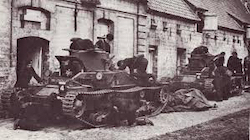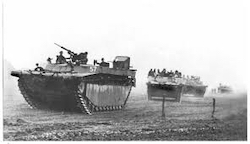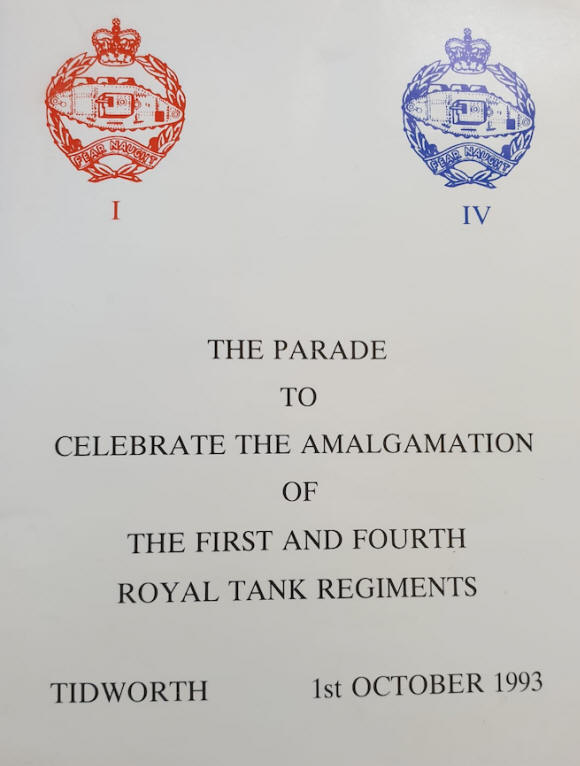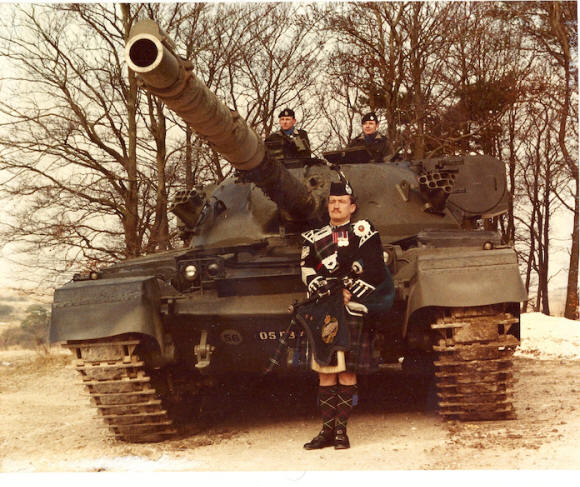|
AS I SAID
in the last episode, I thought it might be useful for
the casual reader if I were to look in a little bit more
detail at the history of the #BARITWE (Best Armoured
Regiment In The World Ever). It started for 4 RTR, and
indeed for the whole of the Royal Tank Regiment, in the
First World War of 1914-18 when tank was introduced by
the British – with much encouragement from one Winston
Churchill – as a means of breaking the deadlock of
trench warfare on the Western Front.
Making its debut at Flesquieres on the Somme on 15th
September 1916, D Company of the Tank Corps, and later D
Battalion, was the historical ancestor of 4th Tonks.
After peace came in 1918 the Tank Corps became the Royal
Tank Corps, which in turn became the Royal Tank Regiment
just before the outbreak of war in 1939. There were
actually three iterations of 4 RTR during the Second
World War.

4RTR Photo 1
The first
was the Regiment that deployed to France in 1939 as part
of the British Expeditionary Force (pictured above). Its
most significant action was the Arras Counterattack on
21st May 1940, when in conjunction with its sister
regiment 7 RTR and two battalions of the Durham Light
Infantry in support, it attacked Rommel’s 7 Panzer
Division and gave the Germans a bit of a fright, albeit
at the loss of most of its tanks. This action may even
have contributed to the decision by Mr Hitler to order
his panzers to stop their dash for the Channel and
helped get the remnant of the BEF away at Dunkirk, but
we’ll never really know. As it was, that was basically
it for 4th Tonks. Most of those remaining got home in
the evacuation but all its equipment was lost.
The second iteration which rose from the phoenix of the
last (although 4 RTR didn’t disappear altogether after
Dunkirk) was reformed from the remnants of the Regiment
and 7 RTR, forming 4/7 RTR for a few months before
returning to its proper title. After re-equipping and
training in the UK it was sent to North Africa in 1941
to take on Rommel and his panzers again. Sadly, it was
part of the Tobruk garrison which surrendered to the
German/Italian enemy on 21st June 1942 and “went into
the bag” as the common parlance of the time might put
it.

4RTR Photo 2
After
that 4 RTR did not appear in the British Army’s order of
battle until 1st March 1945 when, for reasons I don’t
fully understand, 144 Regiment Royal Armoured Corps (RAC)
was re-designated 4 RTR to replace the original
immediately before the Rhine crossing Operation Plunder.
4 RTR crossed the Rhine in its Buffalo amphibious
vehicles (pictured above) on the night of 23/24th March
1945, carrying infantry of the 51st (Highland) Division.
The Regiment ended the war in northern Germany.
In the post war drawdown of the British Army 4 RTR
eventually amalgamated with 7 RTR but kept its title.
After serving in various places around the rapidly
diminishing British Empire, it saw out the majority of
the rest of its days in Germany as part of the British
Army of the Rhine (BAOR). Then, disastrously for all
concerned, the #BARITWE was amalgamated in 1993 with 1
RTR and was no more. Today there is only The Royal Tank
Regiment, a single battalion sized tank outfit based in
Tidworth on Salisbury Plan, where its predecessor 4 RTR
had previously been stationed in 1982-84. This Regiment
carries on many of the traditions of the Fourth,
including Pipes and Drums and the Hunting Rose tartan it
wears, but is very definitely not the same.

4RTR Photo 3
When I
joined 4 RTR in 1980 it was very firmly Scottish and
called itself “Scotland’s Own”. I think we may have had
the highest proportion of Scots soldiers in any of the
Scottish regiments at that time, including the
traditional infantry battalions of the Scottish
Division, but I have no means of proving that claim. The
association with Scotland had developed gradually over
the Regiment’s history, and an important milestone had
been the establishment of its Pipes and Drums – against
general establishment disapproval and resistance, by Lt
Col Laurie New* in the mid 1970s. Be that as it may, we
recruited exclusively in Scotland by the time I joined,
although a few from other parts of the UK and
Commonwealth managed to sneak in. To use a footballing
analogy, getting posted to 4 RTR was like being
transferred to Real Madrid. Everybody who was anybody
wanted to be part of it.

4RTR Pipe Major Harden and a
Chieftain Tank in 1983 at Tidworth
We
weren’t at all like our sister regiments, 1, 2, and 3
RTR, whom we regarded as nice enough but a bit
pedestrian (although 1 RTR had an outstanding CO in Lt
Col Mark Goodson – but he was exported to them from 4
RTR to sort them out!). One senior retired General, who
had all four RTR regiments in his command at one point
or another, recently observed that “4 RTR was a Scottish
regiment that just happened to share a cap badge with
three others”, and I think that’s a fair summary of the
situation. We didn’t actually dislike the other RTR
regiments, we just didn’t seem to have very much in
common with them.
In many ways we probably had more in common with the
cavalry, although you’d have to ask them about that as
well. We called them “donkey wallopers” and didn’t
really meet up with them in the field much, but there
were friendships established on the various courses we
attended together which last up to today. In Munster the
17/21st Lancers were just down the road and there was
much to-ing and fro-ing between the officers’ messes at
the time. They were a nice bunch and we had many friends
there. I also got to know one or two officers from the
Life Guards, the Blues and Royals and from other cavalry
regiments and they always seemed pretty sound to me.
Heaven forfend, but 4 RTR even ran the Tidworth Horse
Trials one year! Our predecessors must have been turning
in their graves, but it was actually great fun.
We did have a special affinity with the Royal Scots
Dragoon Guards (Scots DG), much as we might refer to
them as “Scotland’s other armoured regiment” when we
wanted to irritate them. Their infamous officers’ “Long
Range Destruction Group” was before my time, but its
exploits during visits to our Mess in Munster are the
stuff of legend (More to come? – Ed.) During the 1991
Gulf War we supplied them with a handful of subalterns
and other ranks who saw action with them during the
ground war and all of whom were most complimentary about
their wartime comrades when they returned. I knew a few
of their officers fairly well as did others.
We were therefore hugely disappointed when we learned
that, during the rationalisation of the Royal Armoured
Corps that followed the Gulf War, the RTR hierarchy
spurned an approach from them suggesting that they might
amalgamate with us, as seemed eminently sensible as we
shared exactly the same recruiting area. That new
regiment would have been a force to be reckoned with,
and what a pipe band it would have had! Sadly, as
previously noted, 4 and 1 RTR amalgamated in 1993 to
form a new 1 RTR, and the Fighting Fourth disappeared
from the British army’s order of battle for good, much
to everyone’s regret.
To come in Part 7, working on tanks (at last), exercises
and getting lost.
* Now Lt General Sir Laurie New
© Stuart Crawford 2020 |

